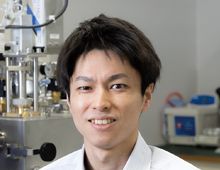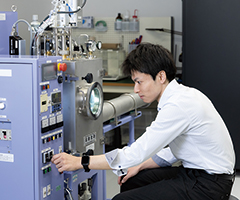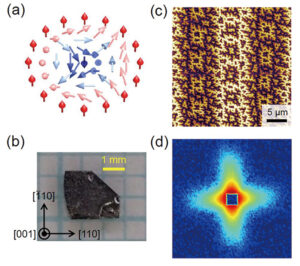Emergent Functional Magnetic Materials Research Unit
Principal Investigator
- PI Name
- Kosuke Karube
- Title
- Unit Leader
- HP
- https://researchmap.jp/karube/
- Brief Resume
2015 Ph.D., Kyoto University 2015 Postdoctoral Researcher, Strong-Correlation Materials Research Group, RIKEN Center for Emergent Matter Science (CEMS) 2019 Research Scientist, Strong-Correlation Materials Research Group, RIKEN CEMS 2023 Senior Research Scientist, Strong-Correlation Materials Research Group, RIKEN CEMS 2023 Unit Leader, Emergent Functional Magnetic Materials Research Unit, Cross-Divisional Materials Research Program, RIKEN CEMS (-present)

Outline

Our unit aims to develop new magnetic materials with topological functions and high-performance magnetic functions based on materials synthesis. We will develop novel intermetallic compounds and alloys using singe crystal growth and rapid quenching methods, and elucidate their magnetic structures and topological properties through various measurement techniques such as magnetometry, scanning probe microscopy, and neutron scattering.
Research Fields
Physics, Materials Sciences, Engineering
Keywords
Strongly correlated electron systems
Magnetism
Topological materials
Results
Development of new room-temperature antiskyrmion materials and observation of magnetic domain structures
Skyrmions are vortex-like topological spin textures and anticipated to be used for spintronics devices. Antiskyrmions are anti-vortex topological spin textures with topological numbers of opposite sign to those of skyrmions. While antiskyrmions have been expected to form in magnets with D2d or S4 symmetry, they have only been observed in Heusler alloys with D2d symmetry. We discovered a new material (Fe,Ni,Pd)3P as a host of antiskyrmions above room temperature. Furthermore, we revealed anisotropic fractal magnetic domain structures in bulk crystals using magnetic force microscopy and small-angle neutron scattering.

(a) Schematic spin texture of an antiskyrmion. (b) Single crystal of (Fe,Ni,Pd)3P. (c) Magnetic force microscopy image of fractal magnetic domain texture. (d) Magnetic small-angle neutron scattering pattern.
Reproduced from [Karube et al. (2022). J. Appl. Cryst. 55, 1392-1400] with permission of the International Union of Crystallography
Members
| Kosuke Karube | Unit Leader | kosuke.karube[at]riken.jp | |
|---|---|---|---|
Nikola Subotic |
Postdoctoral Researcher |
Publications
- K. Karube, V. Ukleev, F. Kagawa, Y. Tokura, Y. Taguchi, and J. S. White
J. Appl. Crystallogr. 55, 1392-1400 (2022)Unveiling the anisotronic fractal magnetic domain structure in bulk crystals of antiskyrmion host (FeNiPd)3P by small-angle neutron scattering
- K. Karube, L. Peng, J. Masell, M. Hemmida, H.-A. K. von Nidda, I. Kezsmarki, X. Yu, Y. Tokura, and Y. Taguchi
Adv. Mater. 34, 2108770 (2022)Doping Control of Magnetic Anisotropy for Stable Antiskyrmion Formation in Schreibersite (FeNi)3P with S4 symmetry
- K. Karube, L. C. Peng, J. Masell, X. Z. Yu, F. Kagawa, Y. Tokura, and Y. Taguchi
Nat. Mater. 20, 335 (2021)Room-temperature antiskyrmions and sawtooth surface textures in a non-centrosymmetric magnet with S4 symmetry
- K. Karube, J. S. White, D. Morikawa, C. D. Dewhurst, R. Cubitt, A. Kikkawa, X. Yu, Y. Tokunaga, T.-h. Arima, H. M. Ronnow, Y. Tokura, and Y. Taguchi
Sci. Adv. 4, aar7043 (2018)Disordered skyrmion phase stabilized by magnetic frustration in a chiral magnet
- K. Karube, J. S. White, N. Reynolds, J. L. Gavilano, H. Oike, A. Kikkawa, F. Kagawa, Y. Tokunaga, H. M. Ronnow, Y. Tokura, and Y. Taguchi
Nat. Mater. 15, 1237 (2016)Robust metastable skyrmions and their triangular-square lattice structural transition in a high-temperature chiral magnet
Contact Us
Hirosawa 2-1, Wako 351-0198 Japan
E-mail:
kosuke.karube[at]riken.jp
